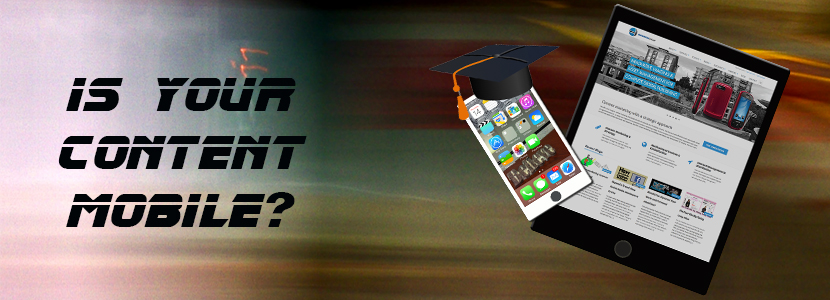Mobile and The “Always On” Digital End User Journey: How to Create Tighter Content to Build Customer Loyalty

EVG’s Eric Ingrand, VP Content Marketing EMEA, hosted a round table at the Digital Content Marketing Summit in London. Below is a summary of the discussion.
Is mobile commerce a reality?
The mobile commerce market is no longer a dream, but a reality. In fact, it has been discussed and forecast for nearly eight years now. The boom, however, has not yet happened although there is plenty of evidence to suggest that it is just around the corner. How ready is your company to respond to this reality? Is it agile enough to adapt its content to mobile devices?
In 2014, mobile moves to the center of the multiplatform landscape. It’s time to ask if your content strategy is heading in the same direction.
What does this mean for brand marketers, creative directors and digital agencies?
Mobile advertising budgets are set to soar by 56% in 2014. According to experts at the Digital Content Marketing Summit, that’s an increase of over US$14 billion. Why the huge increase in budget? Simple: 4G deployment is coming to all big European capitals.
The number of smartphone devices on the market is also on the up. According to eMarketer, the global smartphone audience surpassed the one billion mark in 2012 and is set to reach 1.75 billion in 2014.
What does that mean to my business?
It means a lot of things:
- It means you can offer more personalized content
- It means you need to use responsive design everywhere possible
- It means that social networks have became a full-time companion
- It means great apps to solve your customers’ problems
- It means games to entertain your customers
- It also means that the Big Data is getting bigger, faster and smarter
What are the main challenges today?
Your shop door can never be closed. This was true with the Internet, but is even more important when the device is a phone that can be carried anywhere. As a result, communication with your customers never stops. You cannot afford to sit back and relax and think, “I’ve done all my marketing now”. Complacency is simply not an option. If you don’t have a strategy in place to handle this extra work, you may be in for a rude awakening.
Customers are flighty and less loyal. They can now shop elsewhere at the touch of a button. Loyalty becomes even more crucial as options to switch to alternatives become easier and easier for your customers. Attention spans are shrinking and customers are easily distracted. Do you have a strategy in place to ensure that you are doing the distracting and not your competitors?
If you’re not in the top two or three websites for your key search terms, mobile users are simply not going to find you. Faced with so many challenges, the trick is turning them into opportunities. Remember, solving a problem for your customer means loyalty for your brand.
What were the trends in 2013?
According to econsultancy, the top mobile trends in 2013 were:
1. Emergence of 7inch tablets (look at students on the train, this is fascinating)
2. Mobile payments
3. Contactless services everywhere
Mobile has moved to the center of people’s lives and is quickly becoming the preferred shopping tool as mobile networks grow and the quality of devices improves.
Evidence from the online travel industry
The online travel industry is an excellent illustration of these trends. Not only was it the first industry to truly embrace e-commerce on a global scale, it is also big enough to witness trends early. Check out these stats:
- Desktop bookings declined by nearly 6%, while increasing by over 57% via tablet and more than 86% via mobile in 2013.
- Mobile pageviews more than doubled, while desktop pageviews declined by over 16%.
Revenue from mobile devices nearly doubled as travel consumers become more comfortable transacting via their smartphones and as smartphone penetration reaches an all-time high – nearly 50% in the US.
What does the arrival of 4G really mean?
What does it mean for brands? What does it mean for consumers?
It means that there is an opportunity to connect anytime, anywhere and personalize the content distributed. By creating content that is localized to fit the needs of those searching for it, you can really add value to the customer experience. And the added value is reaping rewards, as evidenced by the increase in mobile commerce.
- In 2014, according to eMarketer, 24% of commerce shopping in the UK will be made on a mobile device.
- This is due to soar to 35% in 2017.
Flashback to times past
Remember when the Internet changed from landline access to high speed ADSL Internet? The same change will happen with mobile thanks to 4G deployment and this is your opportunity to be relevant to your customers. Ecommerce saw a significant rise with the arrival of high speed Internet with sales jumping by 60% in 2000 across many countries due to improved speed and access.
In 2014, how do you use this information to join the mobile revolution and increase brand loyalty? What mobile experiences can you offer your customers to add value for them and for your brand? Look no further than some of the leading US retailers. Shopping apps in use by large retailers such as Nike, Target and Walmart provide an excellent insight into this phenomenon.
Take the Nike training Club App as an example. Users connect with the Nike brand all day long thanks to this app. By offering a tool to help them monitor their health, Nike has added a significant amount of value to their target market and effectively helped them to solve a problem. Some health monitoring systems can come with a hefty price tag. Nike eliminated the need for this expense and provided a free alternative, creating a new touch point with their best customers – sports addicts who like technology and are therefore more likely to share their experience.
Target provides free wifi in-store, as well as an app to enhance the in-store shopping experience, offering consumers store locations, promotions, the ability to scan products for more information, and personalized shopping lists. According to Target, “We know that mobile drives guest engagement with Target and leads guests to shop across all of our channels,”
Walmart adds, “Walmart is particularly aggressive in using mobile to elevate the in-store experience within its apps. The app shifts into an in-store mode when consumers are nearby to a store, which lets consumers view maps of stores and find products within aisles.”
Questions to ask yourself
Before you rush into a mobile strategy, make sure you ask yourself the following questions:
- How do you use mobile content to solve your customers’ problems and challenges?
- How do you integrate local content with mobile content? Is local content something important for your customers at all?
- Do you help them find local content related to your brand on mobile devices?
The three mantras of mobile loyalty
The three mantras of mobile loyalty for 2014 are:
- Make sure you solve a problem for your customer. Be useful – don’t be mobile just to be there.
- Be relevant from a contextual point of view (creating relevant local content is the obvious one).
- Don’t be intrusive. Be very careful how you use personal data. The line between being useful and intrusive is very slim.
We would love to hear about what your company has been doing to solve your customers’ problems on mobile platforms.
Eric Ingrand – VP Content Marketing EMEA



